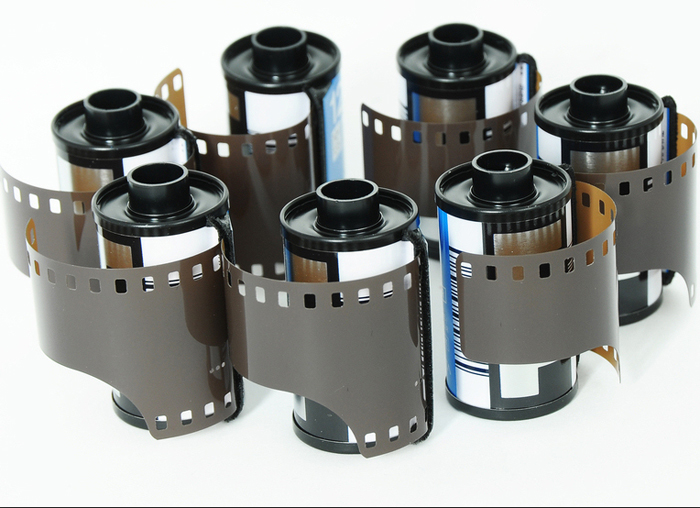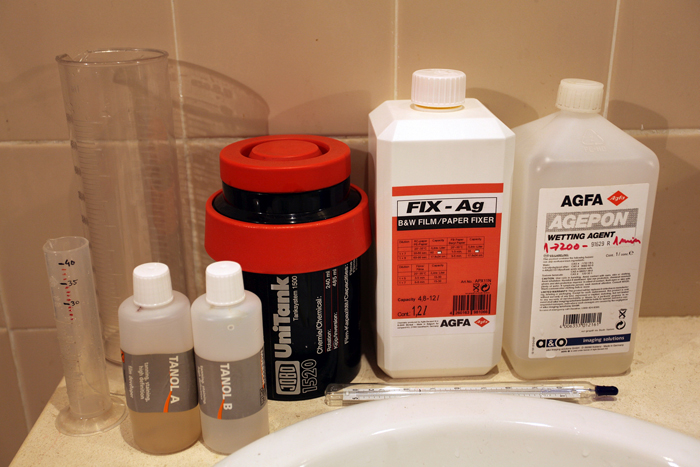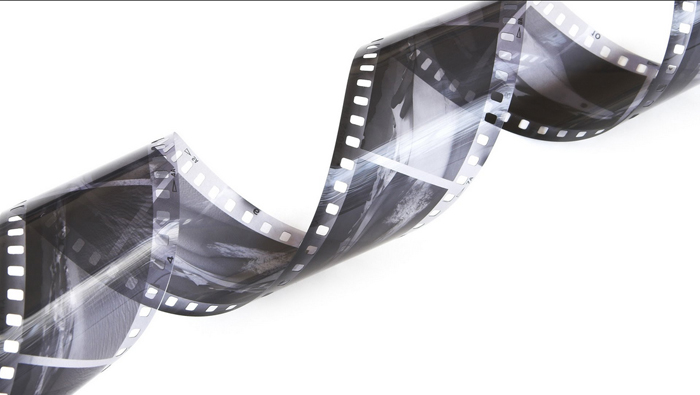SEARCH






|
|
|
|


After speaking about several subjects, related to analogue photography, it's time now to move on and talk about how I develop my own negatives.

There are black & white and colour film. All these have to be developed first if we want to see what secrets are hiding inside. It's always magical, that moment where we point a wet developed negative against a light source and see what resulted from our efforts taking or making some photographs.
I can only develop black & white film, and it's really very easy. Colour film is more complex, because of temperature control and is also very time consuming. Professional labs have all the equipment to do it with precision, and is also where I go to get colour film developed.
Today I will explain how to develop roll film negatives. The procedure is the same for 35mm and 120 sizes. Usually the same tank can be used, changing only the width of the spiral.
An important requirement is a place that can be absolutely darkened and has running water with a sink. I use an interior bathroom with no windows, so after the door is closed, darkness is achieved. If you do not have that, you can buy a changing bag, so that inside you can load the spiral with film and close it inside the tank. After that, all can be done in open light.
Here is the checklist of all that is needed to get started:
* developing tank for roll film. I use a Jobo of the 1500 series, that fits for 35mm and 120mm and is very inexpensive and easy to use
* a thermometer to check the bath temperatures
* developer, I use Tanol, easy to order over the Internet, and the instructions that come with it have all the details on how to use it
* stopping bath, I always use tap water
* fixer and a separate storage bottle, I use Ilford rapid fixer, again on the bottle are instructions, 5 minutes is all it needs
* wetting agent, from Agfa
* distilled water
* stop watch
* graduated container

PROCEDURE
load film into the spiral, in absolute darkness, no leaks of any other source of light, even the faint ones, for example, keep our cell phone outside, even those blinking LEDs can ruin your job; it takes practice to insert the roll into the spiral, practice with a disposed negative until you are comfortable with it, and remember, it has to be handled in the dark: place the spiral into the tank and close it according to your model; usually the instructions on the tank explain it all very well.
now fill the tank with tap water, tapping the bottom for bubbles release, and leave it on the side while preparing the developer. Warm up distilled water to 24C.For my tank I will need 500ml, and in the graduated container add the two parts of the developer, 5ml each. If you choose a monobath, Rodinal, for example, just follow the instructions on quantities. Here in the summer and middle seasons there is no problem with temperatures, tap water is more or less in sync with the developing temperatures of 24C. During the Winter it is more complicated, and the developing bath has to be warmed up. All the other baths and wash steps are made at more cold temperatures but I never had bad results with that.
take out the water from the tank, and replace it with the developer; in this case, developing time is the same for all films, start the clock, 10 minutes for development, meaning agitation during the 1st minute then 10 sec agitation every 3 min; supposing your subject has high contrasts, then developing time can be reduced to 7 min, for example, and if that is anticipated in the field, some exposure increase can be made.
time ending, pour off the developer into the sink, and replace it with tap water, close the tank, and do some agitation, leaving it there for 1 min; then dispose the tap water.
now to the fixer: I use the one from Ilford, bought as stock solution, meaning, it is prepared for use by mixing one part stock to 5 parts distilled water; to keep it, I use dark bottles, and usually prepare 2 litres, because fixer can be re-used, that is, after the stopping bath, pour 500ml of fixer into the tank, agitate every minute for 5min in this case, and at the end fill it again for re-use into the bottle; usually I will use it again for 10 rolls, keeping a record of it.
now you can finally open the tank and take the first glimpse at your work; it's time to wash the film, just place the hose inside the tank, and run water through it for about 15min.
I include here one more step in form of the wetting agent, from Agfa in my case, it comes ready to use directly out of the bottle; after washing time, just fill in distilled water and add a few drops of wetting agent, agitate a little and leave it there untouched for 1 min, then pour it off.
Now the magic moment: open the spiral and take out the roll carefully not to scratch the still soft emulsion and point it towards a light source... there it is, your beautiful negative! Just hang it from a string with a clothes wood clips, one at each end, and suspend it to air dry, if possible in a dust free environment.

This is all there is. After a few hours it will be dried and we can proceed from here to whatever suits our project, scan it, make some contact sheets or enlarge it the conventional way.
This is what photography is all about... Have fun! And if any questions, just ask.
 | Write |
 | Phyllis Clarke CREW Oh..you brought back members....of the changing bag....it was fun and you did not have to wait for someone else to develop your negatives.....and then it was exciting to make the contact sheet and see what you HAD. ..But I will leave it to you....and continue on with digital.
Rui...if you have written this can you tell me what scanner you are using these days...thans..Phyllis |